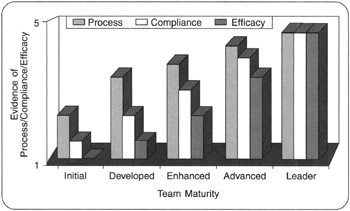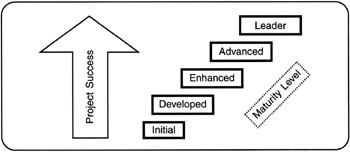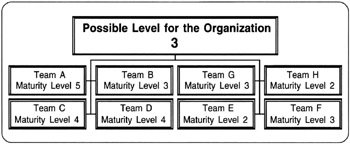5.2 ASSESSING THE VIRTUAL TEAM
5.2 ASSESSING THE VIRTUAL TEAM
The metrics that would determine the success or maturity of virtual teams , or any other project management activity for that matter, must be formalized and consistent. The virtual team procedures and tools can be divided into three categories: common metrics, modified metrics, or unique metrics. Common metrics are those metrics and tools that have been used for traditional teams and can be used for virtual teams with minor modifications (Figure 5.3). These metrics include those that deal with procedures, guidelines, and overall team performance. Modified metrics are those that have been used for traditional teams, but their use for virtual teams will require major modifications and enhancements (Figure 5.4). These metrics include those that deal with conflict management, communication, and team spirit. Unique metrics are ones that will have to be developed specifically for virtual teams to account for their special features (Figure 5.5). These metrics deal with issues of distance communication and the proper use of technology in handling issues and complications that arise only in virtual teams. One needs to be sensitive to this distinction when developing new metrics for a desired aspect of the project management process. However, once the metric has been developed, there is no need to continue to tag it to any specific category.
| |
-
Requirements
-
Scope Definition
-
Estimating
-
Scheduling
-
Document Control
| |
Figure 5.3: Virtual Team Common Metrics
| |
-
New Member Orientation
-
Team-Building Activities
-
Sensitivity to Diversity
-
Conflict Identification
-
Conflict Escalation
-
Conflict Resolution
-
Feedback Solicitation
-
Project Management office Involvement
| |
Figure 5.4: Virtual Team Modified Metrics
| |
-
Official Language
-
Communication Etiquette
-
Preferred Software
-
Preferred Hardware
-
Accommodations for Time Zone Differences
| |
Figure 5.5: Virtual Team Unique Metrics
5.2.1 Assessment Questionnaire
A tool for assessing maturity is useful and helpful for a traditional team, but it is a necessity for a virtual team. Such a tool should provide the capability to determine the effectiveness and efficacy of the team in any and all of the project management functions and activities. An assessment tool should provide an indication of the status of the team based on quantitative and qualitative information that is collected from the performance and behavior of the team. With a detailed diagnosis, the team would be able to develop a program of continuous improvement in order to elevate its level of maturity. The maturity assessment data will provide the foundation for determining priorities for immediate and long-range actions.
One of the more accurate ways to determine the maturity of a virtual team is to use instruments that inquire about the project management facets as they relate to a particular level. Appendix 5A presents such an instrument that can be used to determine the maturity of a team. If most of the statements are accurate for the team in question, then the team has achieved at least that particular level of maturity. The attributes of each level are enhanced versions of the attributes of its preceding level, although in some cases the higher level has features that its preceding level does not. The process of progressive standards is maintained throughout all five levels such that the attributes of Level 5 are higher than those of Levels 3 and 4. In addition, some of the Level 5 attributes are exclusive to Level 5. Figures 5.6 through 5.10 show a topical summary of the items included in the instrument for Levels 2 through 5.
| |
-
Enterprise
-
There Is Inappropriate Staffing
-
There Is Little Organizational Guidance
-
-
People
-
There Is Little Teamwork among the Team
-
-
Things
-
There Are Very Few Procedures
-
| |
Figure 5.6: Level 1 Attributes
| |
-
Enterprise
-
There Is General Organizational Support for Virtual Teams
-
-
People
-
Team Members Communicate with One Another
-
Team Members Collaborate Frequently
-
-
Things
-
The Team Develops a Detailed Team Charter
-
Roles and Responsibilities Are Clear
-
Regular Progress Monitoring Is in Effect
-
There Is Occasional Historical Data Collection
-
| |
Figure 5.7: Level 2 Attributes
| |
-
Enterprise
-
The Virtual Team Plays a Role in Organizational Strategy
-
-
People
-
The Project Manager Is Sufficiently Empowered
-
Open Communication Is the Norm
-
Consulting, Training, and Mentoring Are Available on Demand
-
Team Members Have a Shared Purpose
-
Team Formation Is Quick and Efficient
-
Team Members Collaborate Extensively
-
-
Things
-
Templates Are Available for Many Processes
-
There Is Efficient Progress Monitoring
-
There Is Formalized Change Management
-
Performance Criteria Are Continually Enhanced
-
| |
Figure 5.8: Level 3 Attributes
| |
-
Enterprise
-
The Virtual Team Has Full Organizational Recognition
-
The Virtual Team Members Are Active in Organizational Strategy
-
-
People
-
There Is an Atmosphere of Trust
-
There Is Aggressive Mentoring
-
Fully Effective On-Line Interaction Is the Norm
-
The Work Experience Is Enjoyable and Rewarding
-
-
Things
-
There Is Continuous Enhancement of Procedures
-
There Is Reward and Recognition for Remarkable Performance
-
| |
Figure 5.9: Level 4 Attributes
| |
-
Enterprise
-
The Virtual Team Is a Key Strategic Resource
-
-
People
-
There Is a High Level of Mutual Trust and Respect
-
Risk Taking Is Permitted
-
The Work Environment Is Conducive to Creative Innovation
-
-
Things
-
A Highly Effective Team Charter Is the Norm
-
There Is Continuous Improvement on All Procedures
-
Tools for Learning Are Readily Available
-
| |
Figure 5.10: Level 5 Attributes
It is an important point that the instrument included in Appendix 5A is only one component of the overall team maturity assessment. For a definitive evaluation of the team's maturity, this questionnaire must be augmented by in-depth observation of team members, extensive interviews with stakeholders, and an exhaustive review of documented policies, procedures, and support systems.
5.2.2 An Abbreviated Model
As a first approximation , it would be quite useful to have distinct and identified narrative goals for each level in order to guide the team's efforts to elevate its maturity level. These goals identify, in broad steps, what the team must do to meet the next level of maturity. Goals are not described for a Level 1 team, because it would be highly unlikely that a team would aspire to have ineffective procedures and to anticipate failure in the majority of its undertakings. Therefore, what follows here is a set of goals, expressed as results statements, limited to Levels 2 through 5. These specific goals establish a framework as to how the virtual team can improve its performance to a higher level. On the other hand, reviewing this brief set of goals will provide a rough estimate of the current maturity status of the team. If one knows that none of the team members, nor the project manager, aspire to any of the goals of, say. Level 3, then it would be a good likelihood that the team's maturity is somewhere below Level 3.
Level 2: Developed
-
Goal 1: Virtual team formation is planned and managed.
-
Goal 2: Virtual team communication requirements are determined.
-
Goal 3: Virtual team members meet their commitments according to their plans.
Level 3: Enhanced
-
Goal 1: Team members consider work on a virtual project to be a valuable and sought after opportunity.
-
Goal 2: A common team culture is established as virtual team members are collectively committed to the virtual project.
-
Goal 3: Virtual team members promote and ensure mutual accountability.
Level 4: Advanced
-
Goal 1: Virtual team members establish and enhance the environment for their work.
-
Goal 2: Virtual team members demonstrate a sense of trust, with a focus on shared leadership and professional responsibility for their work.
Level 5: Leader
-
Goal 1: Continuous improvement in virtual team processes and procedures is fostered.
-
Goal 2: The virtual team environment supports continuous learning and professional and personal development.
5.2.3 Indirect Assessment
Another quick evaluation method can be formulated on the basis of the sophistication of the project management processes. One would examine the existence of, compliance with, and efficacy of the project management procedures in each of the knowledge areas. For consistency with maturity models, a scale of 1 to 5 is used in each of the elements, and one would assign a score for each of the process attributes (i.e., existence, compliance, and efficacy). If these values tend to cluster around 1, 2, 3, 4, or 5, then that is the rating that is assigned to the team (Figures 5.11 and 5.12). It is important not to become overly concerned with precise averaging which might give the illusion of accuracy. This technique is a first approximation and not a definitive assessment methodology, although it can serve as a useful tool.
| Process | Compliance | Efficacy | |
|---|---|---|---|
| Scope | 5 | 5 | 5 |
| Quality | 5 | 5 | 5 |
| Cost | 5 | 5 | 5 |
| Time | 5 | 5 | 5 |
| Risk | 5 | 5 | 5 |
| Integration | 5 | 5 | 5 |
| Human Resources | 5 | 5 | 5 |
| Communication | 5 | 5 | 5 |
| Procurement | 5 | 5 | 5 |
Figure 5.11: Team Maturity Based on Project Management Process: Level 5, Leader

Figure 5.12: Maturity as a Function of Process Sophistication
5.2.4 Implications of Team Maturity
For virtual teams, or for traditional teams for that matter, a success structure can be developed somewhat similar to the success structure for projects (Rad and Levin, 2002). Then the maturity of teams can be measured in terms of how well each element of the success structure can be executed. Given that the performance characteristics that reflect process maturity are very closely linked to those that describe the success of projects undertaken by the same team, one can make inferences from one set of observations to the next. Figures 5.13 and 5.14 show stylized depictions of the relationship between the maturity level and the success of the same team in carrying out the various functions that deal with the knowledge areas of project management. The premise is that sophisticated teams are the ones that routinely produce successful projects.

Figure 5.13: Team Performance

Figure 5.14: Organizational Maturity
There is a direct relationship between team maturity and the success of the projects that the team undertakes. If the maturity of the team is at, say, Level 3, then there is every expectation that the success rating of the team's projects is also at three. Carrying this relationship one step further, if several of the teams in an organization have reached a maturity of four, then there is every indication that the organization has the infrastructure to support a maturity of four for all of its teams (Figure 5.15). Setting such a goal and achieving it is a straightforward matter because organizational examples of metrics have already been established within the more progressive teams. Finally, if all of the teams in an organization achieve a maturity of five, then there is every likelihood that the organizational performance attributes are also at Level 5. By extension, the success indicators of the collective suite of projects that are undertaken by the organization will also be at Level 5. Notwithstanding all of these inferences, the most accurate way to determine an organization's maturity is to conduct a formalized maturity assessment. Likewise, the best way to determine the overall success of virtual projects is to sum up the success indicators of individual projects, which in turn have been determined using formalized structures and rating schemas.

Figure 5.15: Organizational Maturity
EAN: 2147483647
Pages: 75